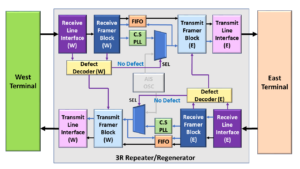This blog post aims to briefly define and describe the pF_DS (Far-End Defect Second) Performance Monitoring parameter that the OTN PTE (or ODUk_TT_Sk Atomic Function) will compute and generate.
The OTN PTE (or ODUk_TT_Sk function) will include information on pF_DS without each Performance Monitoring report that it sends to System Management.

NOTES:
- The OTN STE (OTUk_TT_Sk Atomic Function) also monitors and generates information on the pF_DS (Far-End Defect Second) parameter at the OTUk Layer. Please see the pF_DS at OTUk Layer Post for more details on this parameter.
- Throughout this post, I will use the terms: OTN PTE and ODUk_TT_Sk Function interchangeably. In the context of this blog post, these two terms mean the same thing.
Introduction
At the ODUk Layer, the OTN (Sink) PTE is the entity that is responsible for detecting and reporting Far-End Defect Second events.
As the OTN PTE receives and monitors its incoming ODUk signal, it will check for many things. It will continuously check for the incoming ODUk signal for Service-Affecting Defect (e.g., dAIS, dOCI, dLCK, dTIM, etc.) as well as bit (or symbol) errors (e.g., PM-BIP-8 errors and PM-BEI errors).
Another thing that the OTN PTE will do (as it continuously monitors its incoming ODUk signal) is to divide each second of (monitoring) time into the following two categories:
- Far-End Available (Working) Seconds, and
- Far-End Defect Seconds
Anytime the OTN PTE detects and categorizes a given one-second period as being a Far-End Defect Second, it will increment the pF_DS parameter and report that information to System Management.
New Comprehensive OTN Training…. Available Now. Click on the Banner Below to Learn More!!
Discounts Available for a Short Term!!
So When does the OTN PTE detect and flag a given One-Second Period as being a “Far-End Defect Second”?
ITU-T G.798 presents the following Performance Monitoring Equation for the ODUk_TT_Sk function.
pF_DS <- dBDI
Where:
dBDI is the current state of the ODUk-BDI or the Backward Defect Indicator Defect (at the ODUk Layer).
The OTN PTE (or ODUk_TT_Sk function) will continuously evaluate the above equation as it monitors its incoming ODUk signal.
This equation states that the OTN PTE will declare a given one-second period as being a Far-End Defect Second if it has declared the dBDI defect condition during any portion of that one second.
A given OTN PTE will declare a one-second period as a Far-End Defect Second if the remote OTN PTE declares any of the following defect conditions:
- dAIS (ODU-AIS)
- dOCI
- dLCK
- dTIM
In this case, the OTN PTE will increment the pF_DS parameter for each one-second period it categorizes as a Far-End Defect Second.
Conversely, the OTN PTE will declare a one-second period as an Available Second if the remote OTN PTE is not declaring any of the defects mentioned above. The OTN PTE will NOT increment the pF_DS parameter in this case.
What Does This Mean in English?
Of course, if the OTN PTE declares the dBDI defect condition, then this also means that the remote PTE is declaring a service-affecting defect condition. In other words, the pF_DS parameter reflects the health of the remote (or Far-End) terminal.
If the remote terminal declares no service-affecting defects, the near-end terminal will not increment the pF_DS parameter. On the other hand, if the remote terminal declares a service-affecting defect, then the near-end terminal will increment the pF_DS parameter.
So, if the ODUk_TT_Sk function has declared the dBDI defect condition for even a fraction of a given one-second period, it will declare it as a Far-End Defect Second. It will also set the parameter pF_DS to 1 and report that information to System Management.
Conversely, if the OTN PTE determines that the ODUk_TT_Sk function did not declare the dBDI defect condition at all during a given one-second period. In that case, it will declare that one-second period is a Far-End Available (Working) Second. In this case, the OTN STE will NOT set the parameter pF_DS to 1.
Hence the pF_DS parameter reflects the network’s health at the remote terminal (e.g., the other end of the ODUk Path).
Is there such a thing as a Near-End Defect Second?
Throughout this post, we have used the term: Far-End Defect Second. Does this mean that there is another parameter called Near-End Defect Second?
Answer: Yes, there is such a parameter. See the Near-End Defect Seconds (pN_DS) post at the ODUk Layer for more details.
Clueless about OTN? We Can Help!! Click on the Banner Below to Learn More.
Discounts Available for a Short Time!!
And Finally, Click on the Image Below to see More OTN-Related Topics in this Blog.







